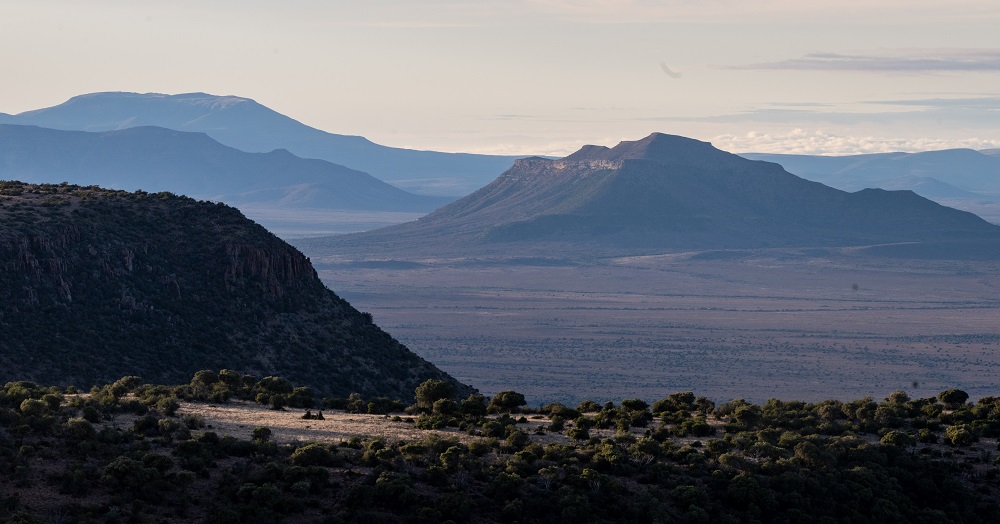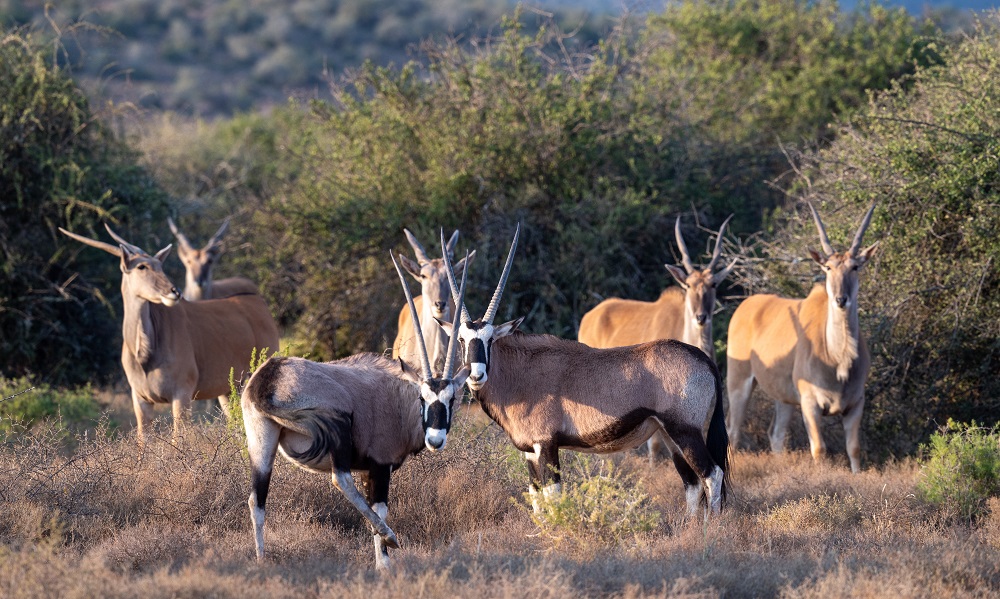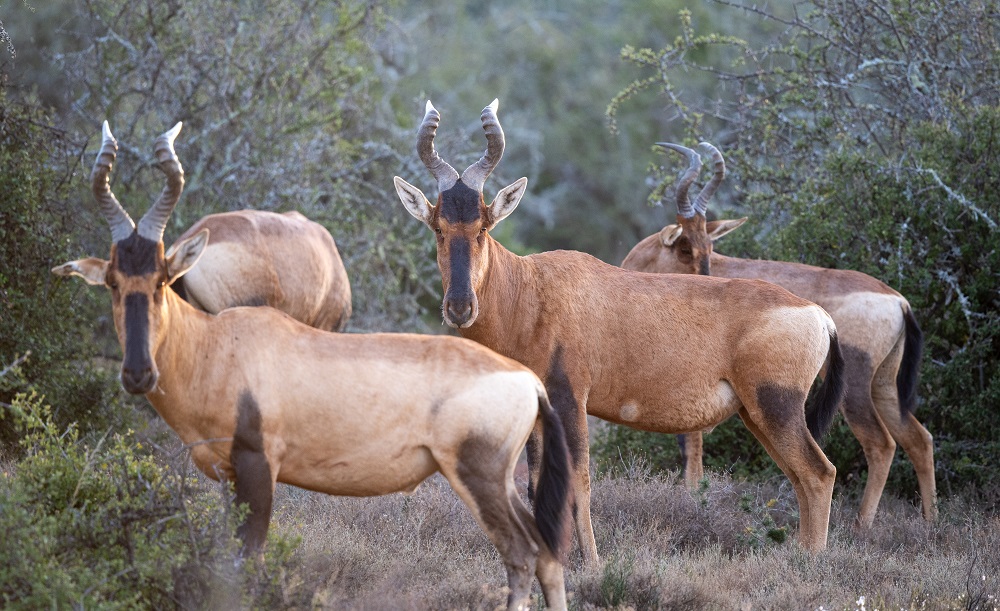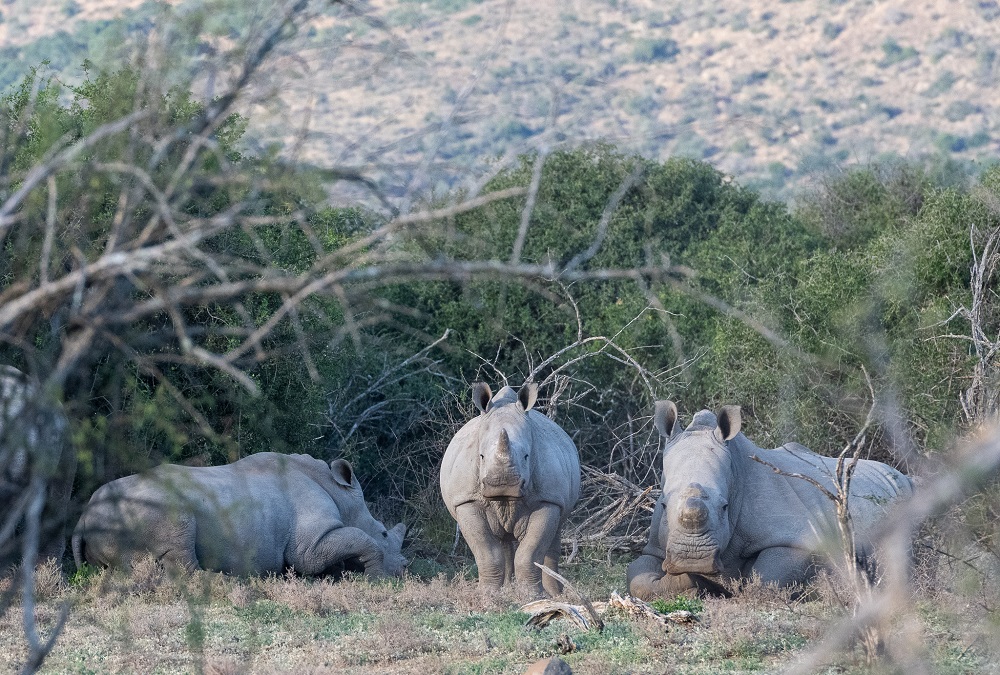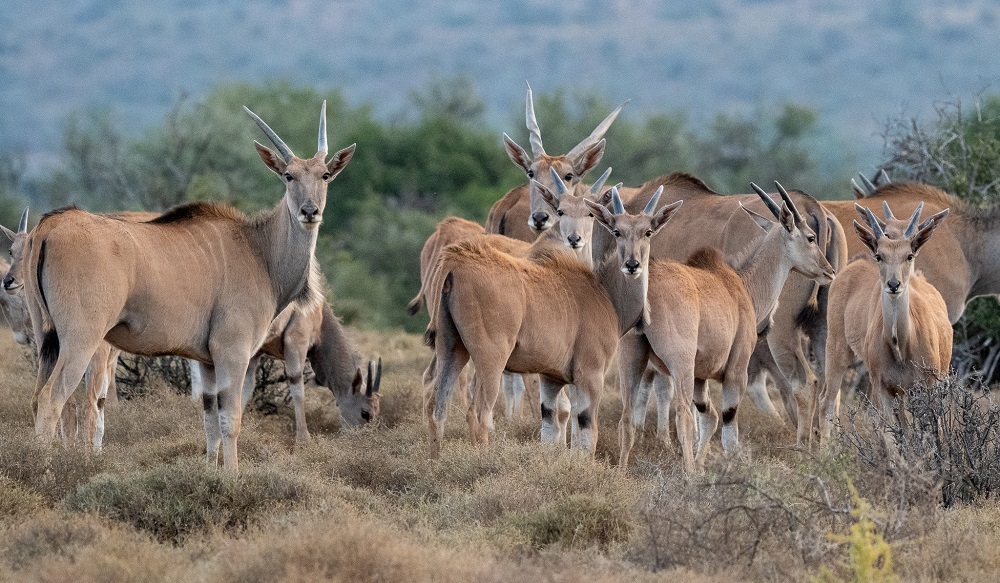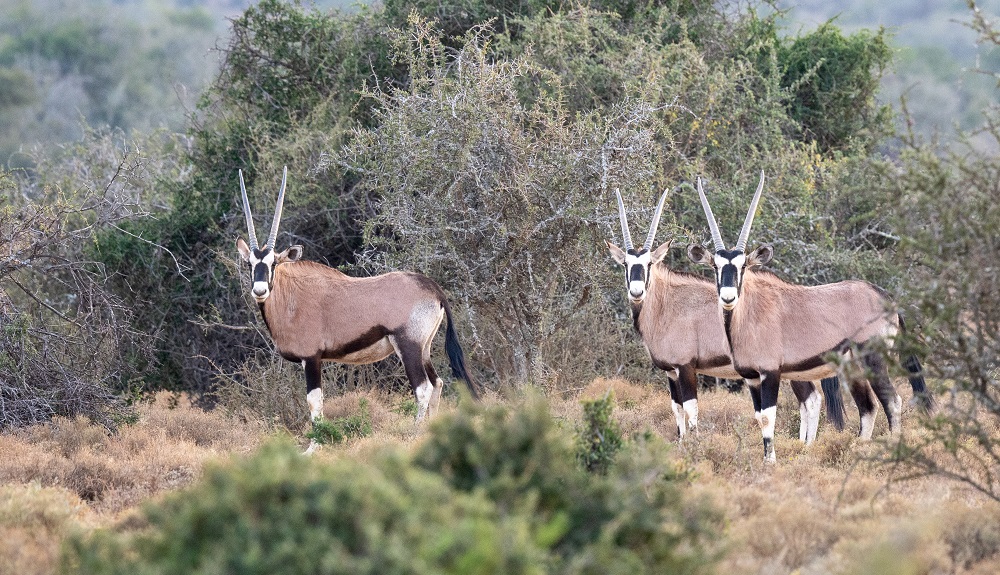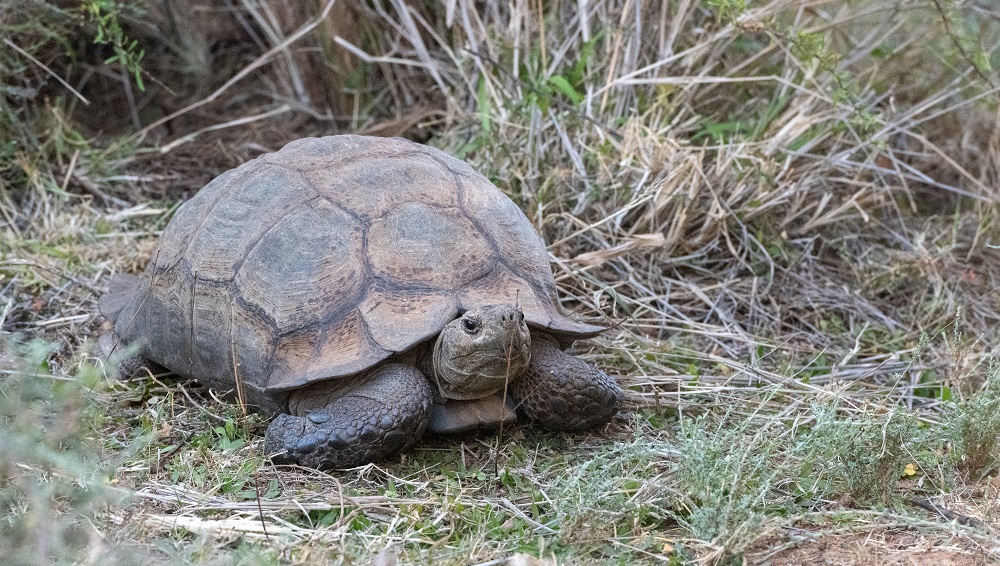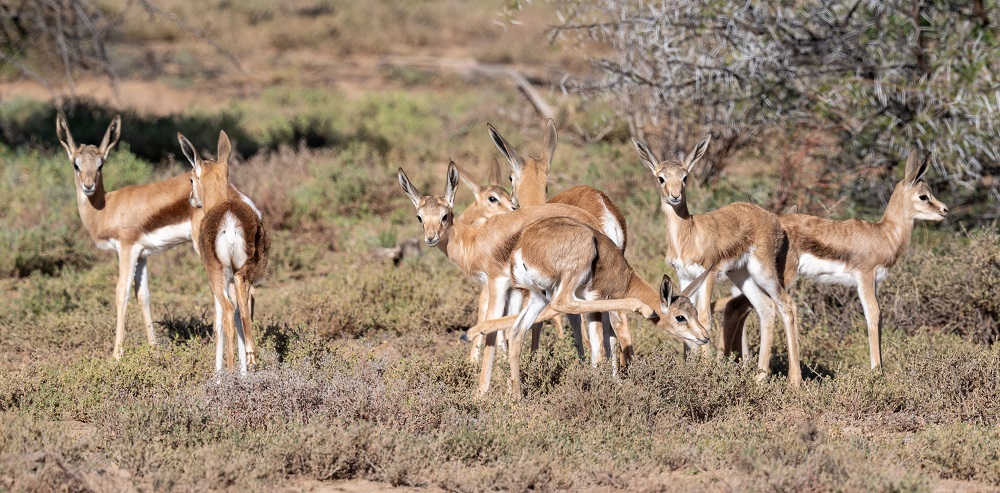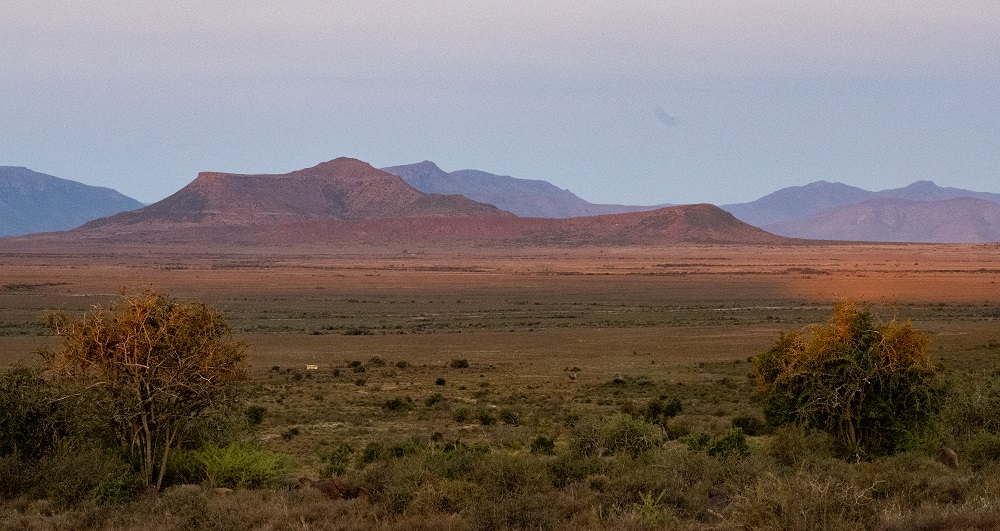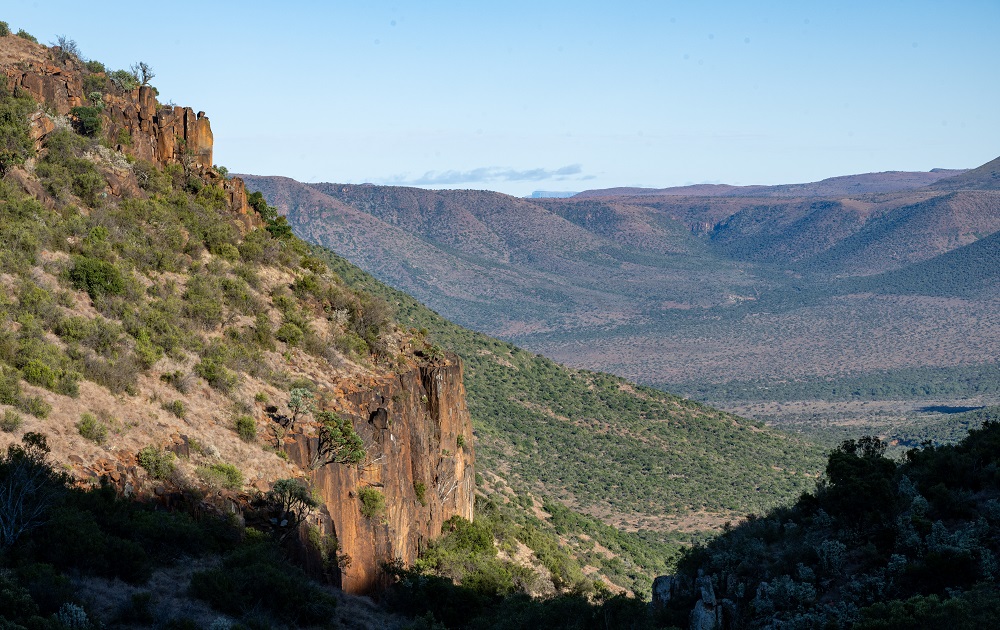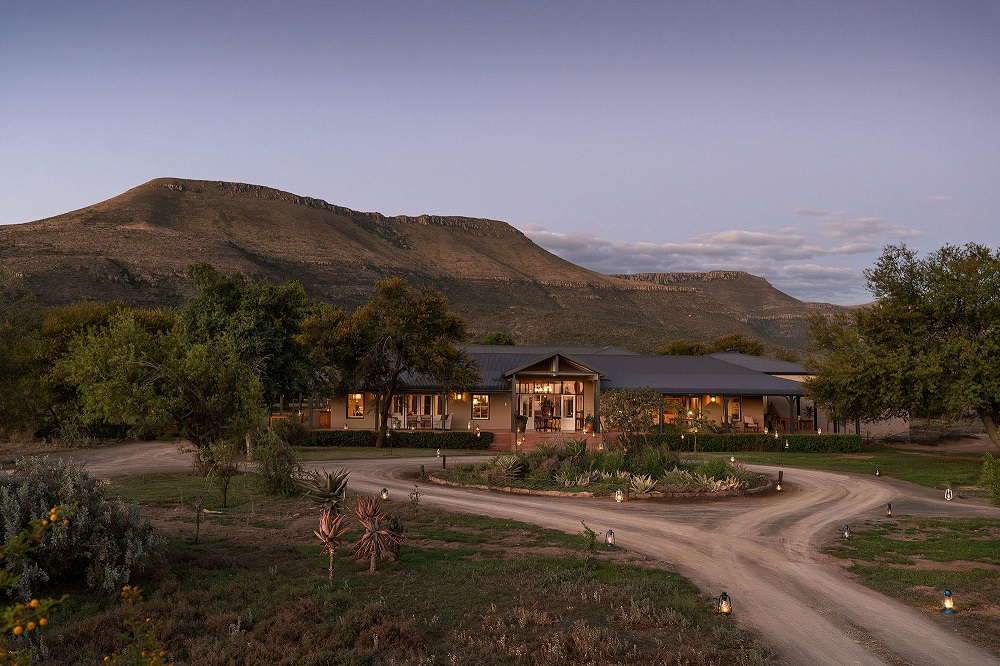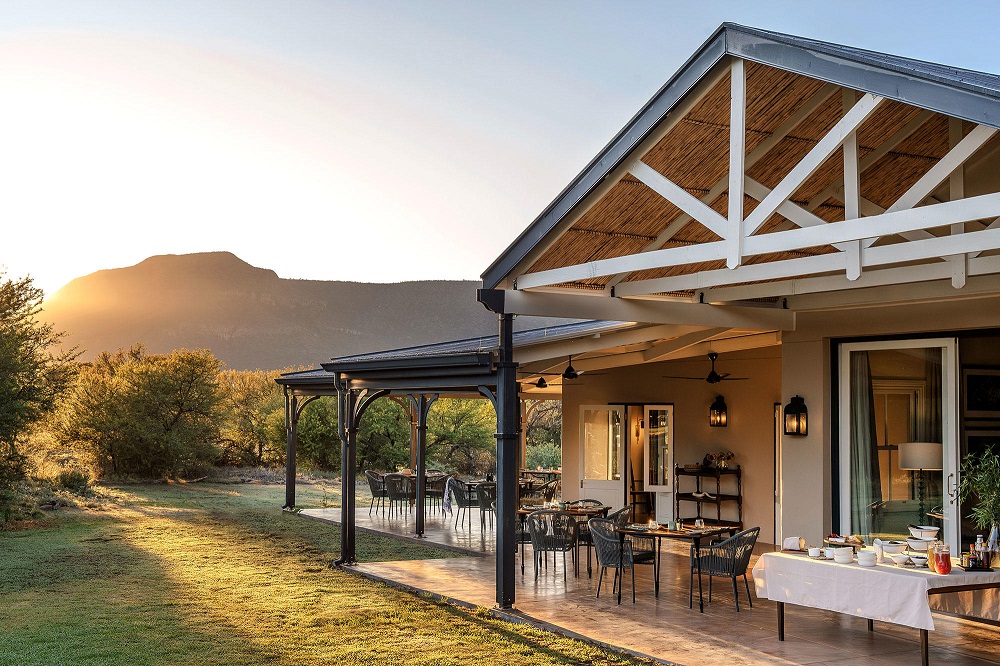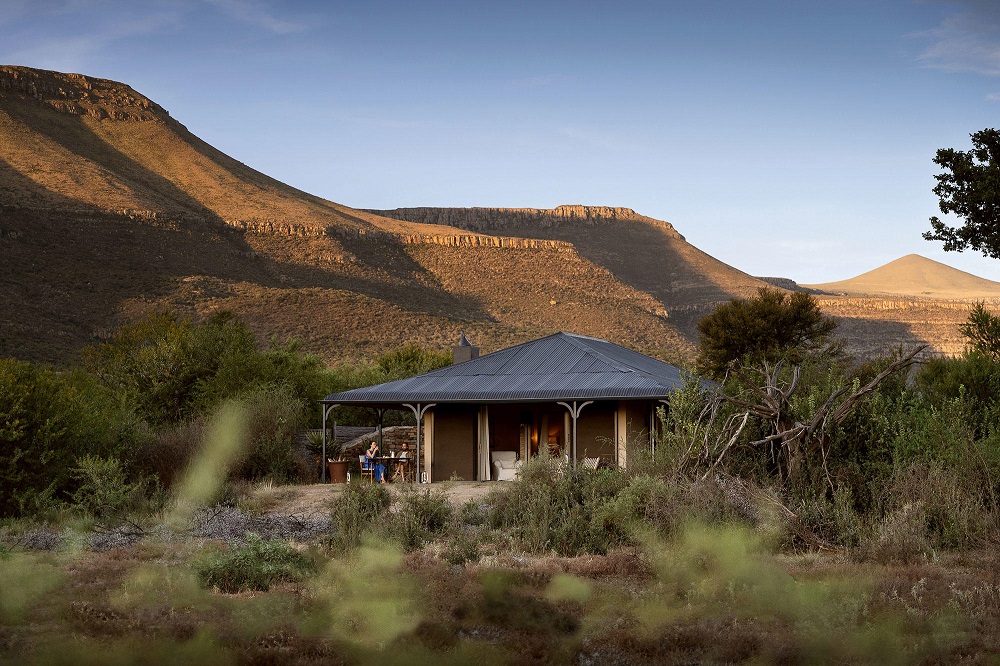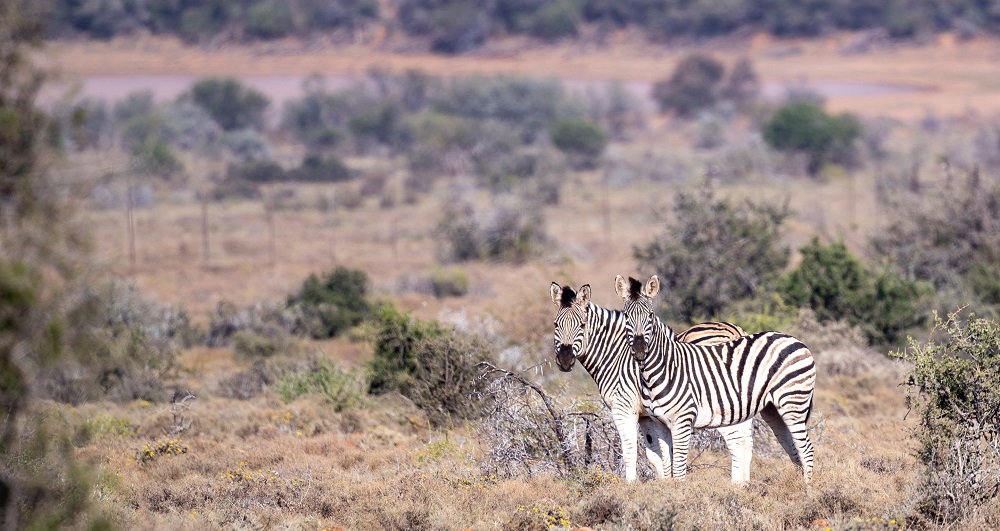Spending a couple of days at Samara Karoo Reserve in the heart of South Africa’s Great Karoo semi-desert is as close as one could ever get to being in a Pierneef landscape. Pierneef, arguably South Africa’s greatest and most celebrated painter, is famous for his hugely evocative landscape paintings, several of which depict Karoo-like scenes in a highly stylized, impressionistic manner.
Drive around Samara reserve for a day or two and more than just one of the stunning Camdeboo mountain landscapes will surely remain etched in your mind, as impactful as any Pierneef. Each view, each sunset a masterpiece for the ages.
Like so many South Africans by birth, my impressions of the Karoo have always been woefully short of the reality of this splendid area. Despite more than 30 years of driving through it, crossing it by train and flying over it, I could never see it for what it was. All I saw was open, featureless plains with a few drab koppies (inselbergs) in the distance. Mile after mile of nothing much, just trains sweeping by at night and glimpses of Karoo towns, deserted by 5 pm. Mentally, I had reduced the Karoo to a seemingly never-ending drive through a vast nothingness. A space that simply had to be endured, to get to where you really wanted to be. Which was invariably Cape Town to the south, or home, in the other direction.
It was only when I saw the Great Karoo again this last summer with older but wiser eyes, stripped of many of the prejudices of my younger years, that I could appreciate it for what it really is. An achingly beautiful and infinitely charming landscape. A living, breathing semidesert area which was once – and now is again at least in part – home to an astonishing variety of large mammals.
At one time the Great Karoo was synonymous with vast migrating herds of springbok, sometimes numbering into the hundreds of thousands, taking days to pass through an area. Historically, the wildlife of the Karoo included black-maned Cape lions, rhinos, cheetahs, the now extinct quagga (a species of zebra) and several unique mammals such as the Cape fox, eland, caracal, suricate and aardvark. Decades of non-sustainable agricultural practices – primarily overgrazing – resulted in erosion and even desertification, negatively impacting biodiversity. In time, it resulted in many of the larger mammals disappearing. The last Karoo lions were seen around 200 years ago.
Enter Mark and Sarah Tompkins – and other conservation-minded individuals and families – who are now turning back the clock on agricultural exploitation with an ambitious program of land rehabilitation and wildlife reintroduction. Since first acquiring the farm Apieskloof in 1997, the Tompkins family have amassed enough land to establish a self-sustaining ecosystem which supports wildlife – all the way from the herds of antelopes that used to inhabit the area to the predators to keep the balance which helps maintain these fragile ecosystems.
It is a tedious, painstaking process to eradicate alien, invasive plant species, to tear down internal fencing and to simply rest the land for a sufficiently long period of time. All while rehabilitating the most eroded, degraded areas, planting indigenous vegetation and slowly reintroducing indigenous animals.
Getting Samara to what it is today started with a dream, involved years of hard work, unwavering dedication, substantial financial investment and the ongoing efforts of a team of people who are passionate about spreading the environmental message to everyone who set foot on the reserve. There were many rewilding milestones along the way: the first cheetahs in 130 years, the first elephants in 150 years, the first lions in 180 years. It is a remarkable conservation success story in an area which remains largely unknown even to South Africans, let alone international visitors.
In search of cheetahs and more – activities at Samara
Kathy and I arrived at Samara in late August after a drive of about four hours from Sedgefield on South Africa’s Garden Route, our (US) summer base. As if on cue, just after we had negotiated a shallow drift crossing the small Milk River, just around the corner from the main lodge, a large tower of giraffes appeared among the trees on both sides of the road. Acting every bit like a welcoming committee, they slowly moved to the left and right, all while of course staring at us intently and without making a sound, in typical giraffe manner. Observing such a relaxed journey of giraffes so close to the main lodge – and clearly not fussed by the proximity of our vehicle – was a good omen.
With one exception – being the Samara cheetahs evading us – every game drive exceeded our expectations. On our very first game drive, there were more groups of giraffes, then some handsome waterbuck and – not far from the lodge – a group of four white rhinos. An adult female with a youngster and two young males. We got out of the vehicle and approached the rhinos on foot – carefully and quietly – with our guide Roelof and tracker Kevin.
On every drive at Samara – we were only there for two nights – we saw a wealth of plains game including impressive numbers of eland (South Africa’s largest antelope), the striking gemsbok, red hartebeest, herds of springbok and warthog families running as if their lives depended on it. By morning’s end on day one, our growing mammal list topped 20 species with yellow mongoose, vervet monkey and chacma baboon added to it while driving through the thickets in the small valley adjoining the lodge. A high point was spotting a particularly large herd of eland which let us approach quite closely. This is uncharacteristic of eland which have the longest flight distance of any of the African antelope species.
The following day, the plan was to go out in search of one or more of Samara’s healthy and growing number of cheetahs, several of which are collared for ongoing research projects. Which makes it relatively easy to find them, under normal circumstances. Most Samara guests who spend three nights or so in the area, do in fact get to approach the cheetahs on foot, observing them at ground level. A singular experience. The drive took us a very long distance to the southern open grassland area but despite our guides giving it their best, we did not catch a glimpse of them. It was a little disappointing as Samara prides itself on their ‘walking with cheetahs’ experience. Unfortunately weather conditions were unfavorable with a strong wind driving the cheetahs into a high hilly area which we could not reach on foot due to timing constraints. We plan on returning to Samara next summer so we’ll file this under ‘to be continued.’
On our last morning drive Roelof and Kevin took us all the way to the top of the high plateau area, a huge expanse of grass-covered savannah plains, sometimes referred to as the ‘Serengeti of the South.’ We reached it after an exciting and sometimes fairly steep but fascinating drive, with amazing views front, left and center. At around 1,500 meters above sea level (or as we would say in Texas – a mile high), the fresh mountain air was crisp and cool. Samara is beautiful but this particular area is uniquely beautiful, being perched high on a mountain saddle with 360 degree views, surrounded by purple mountains and massive valleys in seemingly every direction. Not surprisingly, we encountered several different species up there including Cape mountain zebra, mountain reedbuck, bat-eared fox and a couple sizable herds of black wildebeest in addition to lots of springbok and eland.
An unexpected bonus on the drive back down from the plateau was coming up on a fresh lion kill. And I mean fresh. Roelof and Kevin saw some fresh lion tracks crossing the path and got out of the vehicle to investigate. Not 30 seconds later, they were back into the vehicle, having spotted a male lion barely 10 meters off the track. Inching forward a little bit, we saw the lion looking in our direction, and through an opening in the bushes, there was a seemingly untouched but clearly dead eland bull. We had inadvertently interrupted the lion’s attempt to start feeding. I took a couple of photographs and we moved on; pleased to have seen one of the big cats in this environment but not wanting to insert ourselves into the aftermath of a kill.
Getting there
Samara is located in South Africa’s Eastern Cape Province, about 33 miles south-east of Graaff-Reinet, South Africa’s fourth oldest town, in the very heart of the Great Karoo. All along the drive up to Samara from the Garden Route coast, Kathy and I felt like we were in a misplaced movie set. Being residents of the flat and featureless Texas coastal plains, even the most mediocre of hills impress us but this drive was simply spectacular. It started with a bang, negotiating the stunningly beautiful Outeniqua Pass, not far out of the coastal town of George. Being stuck behind a slow-moving truck is not a hindrance or nuisance there. Quite the contrary. All the more time and opportunity to steal glances in every direction, even if you’re not supposed to, from behind the steering wheel.
Emerging from the pass we thought the landscape bonanza was at an end, but we were wrong. It went on and on literally all the way to Graaff-Reinet, and beyond, right up to and including, of course, Samara itself. One magical vista would fade away only for another to take its place.
The asphalt road was in excellent condition all the way from George and the traffic was light, to put it mildly. Inexplicably, certain stretches of the highway were conspicuously marked with large signs which read “High Accident Zone.” With so few other vehicles around, one has to assume this refers to single vehicle crashes. Very few Houstonians are likely to doze off in such spectacular surroundings but the rest of you – take it easy and stay alert.
I can’t speak to the condition or the visual attractions of the road from Gqeberha (formerly Port Elizabeth), but it is the shortest and most direct way to get to Samara from a major airport. The distance of about 170 miles can be covered in roughly 2.5 to 3 hours. Port Elizabeth Airport (PLZ) can be reached by commercial flights from Johannesburg, Cape Town and Durban. Of course, if you were to travel with Fish Eagle Safaris you would likely reach Samara on a pre-planned road transfer from Port Elizabeth Airport.
It’s also possible to drive to Samara from Cape Town, taking up to 8.5 hours along the scenic route 62, considered to be one of the top road trips in South Africa. It is advisable to make this a two-day trip – a journey which we are planning for the summer of 2025. From Samara it takes about 6.5 hours to drive to the Cape Winelands centers such as Stellenbosch or Franschoek along the fastest and most direct route, the N1.
There’s a private gravel airstrip at Samara and an asphalt airstrip in nearby Graaff-Reinet, so the area is reachable by private charter flight from anywhere in South Africa.
Understated elegance: Accommodation, food & hospitality
General manager Marnus Ochse personally welcomed us at the front entrance of the main building at Samara’s Karoo Lodge, a beautifully reimagined Karoo farmhouse. Marnus’ presence and manner instill confidence and exude a sense that he and his team are on top of things. And so it was. Over the course of our two days my favorable first impressions were confirmed and exceeded. The accommodation certainly leaves nothing to be desired. When we were not busy exploring – which was most of the time – we were warmly and comfortably ensconced in the impressive room #7 at Karoo Lodge. Over the years we have seen and experienced dozens of deluxe lodges all over Africa and Samara’s Karoo Lodge does not have to take a back seat to any of them. To the contrary. By retaining the lodge’s quintessential Karoo character while embracing a modern approach to safari living, Samara’s owners have created something really special and unique. The expansive wraparound verandah abutting the main building is a good example of what makes Samara worth going out of your way for. On my next visit I am 100% going to schedule some time to simply enjoy the fresh, clean Karoo area right there. Taking my time over a cup of decaf Americano while my eyes wander over the craggy, mysterious landscapes in the far background.
Having been extensively renovated in 2023, Karoo Lodge now has 10 suites, eight Karoo Suites and two Karoo Family Suites, sleeping up to 24 guests total. Our Karoo Suite #7 is ideal for a couple, complete with romantic four-poster bed, a fireplace (yes we used it), air-conditioning, a large separate bath, plus indoor and outdoor showers. Hopefully next time we will have a bit of time to spend in the covered patio overlooking the dramatic mountain landscapes, binoculars ready to spot a few birds and maybe a black rhino coming to drink at the waterhole.
The main lodge – where we enjoyed our meals – was as welcoming and comfortable as it gets, with a pleasing blend of natural tones and fabrics creating a warm Karoo homestead setting. There’s certainly plenty of room and as much privacy as anyone could desire with two sitting rooms, a separate dining room, library, a farm-style kitchen, colorful plant-filled courtyard, wine cellar, a story room and of course the aforementioned verandah. Make yourself at home.
Kathy and I very much enjoyed the cooking at Samara. Probably a little too much. We have a penchant for Karoo lamb and there we were, finding ourselves smack in the middle of the Great Karoo in a place where lamb takes pride of place on the menu. So yes we tried their famous Karoo lamb burger and several other South African classics prepared with locally sourced ingredients. Breakfast – served in the crisp morning air outside on the verandah – was equally delicious and fun with a selection of fresh fruit, cold meats, yogurt and cheeses. Those being the precursor to an old-fashioned Karoo hot breakfast with eggs like you like them, lamb sausage (naturally), freshly grilled tomato and sauteed mushrooms. We also managed to squeeze in a pre-game drive afternoon tea-time snack, a superb baked cake.
To find out more about Samara and to learn how it can best be worked into a unique South African experience, email Bert at bert@fisheaglesafaris.com or leave a message with our answering service at 1-800-513-5222, any time.


